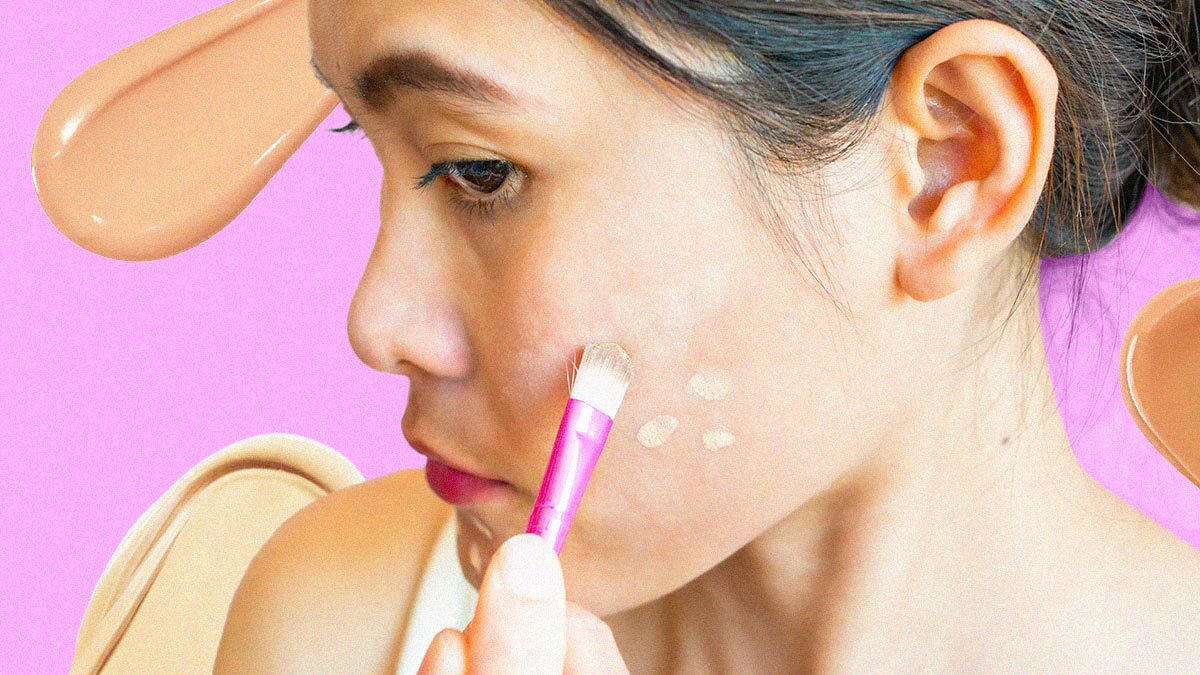Concealer is an indispensable tool in the beauty world, often considered a magic wand in the cosmetic makeup bag. Whether you're aiming for a flawless finish or to camouflage those little imperfections, it’s crucial to understand what a concealer is.
From getting to know concealer makeup trends and learning how the applications, let’s harness its full potential.
What is a Concealer?
A concealer is a type of cosmetic product used to cover imperfections on the skin such as discoloration, blemishes, and scars.
Concealers come in various forms, including liquids, creams, sticks, and even powder. They come in various shades of skin tone, but other colors like peach, green, and lavender are also available.
General Ingredients
Concealers have similar ingredients to foundations because concealers are essentially foundations with better coverage. The consistency of formulations can vary from liquidy and slightly sheer to thick and full coverage. Here are some common ingredients:
- Pigments. To provide color and coverage. Titanium dioxide and iron oxides are commonly used for their opacity and range of colors.
- Waxes and Oils. Beeswax, carnauba wax, and various botanical oils ensure the product glides smoothly over the skin, providing moisture and structure.
- Emollients. To facilitate blend-ability and comfort on the skin.
- Silicones. Often used in formulations for their smoothing effect, making pores and fine lines less visible.
General Applications
Concealer can be used in various ways to enhance the skin's appearance:
- Under-eye Concealing. To cover dark circles and brighten the under-eye area.
- Spot Concealing. To cover blemishes, scars, and spots for a more even skin tone.
- Highlighting. Lighter shades of concealer can be applied to high points on the face to highlight and add dimension.
- Correcting. Color-correcting concealers use complementary colors (green, lavender, peach) to neutralize specific tones like redness or under-eye circles.
How It Works
Concealer provides concentrated coverage, blending seamlessly with the skin or foundation to conceal imperfections. Shade and formula choice are essential in achieving a natural, undetectable finish.
Proper application and blending techniques also matter. Using too little or too much product can result in sheer coverage and a textured finish. Individuals can use tools like brushes, sponges, or their fingers to apply and blend the product on the skin.
Concealer Trends
Concealer usage adapts to evolving beauty trends. Recent trends include:
- "No-Makeup" Makeup Look. Concealer is strategically instead of using a heavy coverage foundation to achieve a naturally flawless look.
- Multi-Use Products. Concealers doubling as a contour or highlighting product, emphasizing their versatility.
- Inclusive Shade Ranges. Brands have expanced their concealer shade ranges to cater to a broader spectrum of skin tones.
- Skincare-Meets-Makeup. The development of concealers infused with skincare ingredients like hyaluronic acid, vitamin C, and SPF to provide treatment benefits in addition to coverage.
Concealer Variations
Color-Correcting Concealer
Concealers with specific colors (green, lavender, peach, etc.) are designed to neutralize discolorations like redness, sallowness, or blue-toned under-eye circles.
Best For
Targeting and neutralizing specific skin discolorations before applying foundation or concealer.
Pros
- Effective in addressing and neutralizing particular color concerns.
- Helps achieve a more even skin tone.
Cons
- Requires an additional step of applying a skin-toned concealer or foundation on top.
- Can be tricky to use without proper knowledge of color theory.
Cream Concealer
Thicker and more pigmented than liquid, cream concealer provides substantial coverage and typically comes in pots or palettes.
Best For
Great for spot-concealing hyperpigmentation and acne.
Pros
- Offers excellent coverage.
- Long-wearing and does not require frequent touch-ups.
Cons
- Can feel heavy on the skin.
- Might look cakey when too much is applied.
Hydrating Concealer
A concealer formulation infused with moisturizing ingredients, offering lightweight coverage and a luminous finish.
Best For
Dry or mature skin types. Perfect for under the eyes.
Pros
- Moisturizes while concealing, preventing the area from looking cakey or crepey.
- Often contains ingredients beneficial for skin health.
Cons
- May not offer enough coverage for those with significant blemishes or discoloration.
- Could wear off more quickly than other types, requiring touch-ups.
Liquid Concealer
A runny concealer with varying degrees of coverage, from light to full, and comes in different finishes such as matte, dewy, or satin. Usually comes in a tube with a sponge-tip wand` applicator.
Best For
Best used for larger areas due to the easy spreadability of its runny texture. Common areas include under the eyes and redness on the cheeks, nose, and forehead, Can also be used to highlight or contour the face and nose.
Pros
- Versatile for any part of the face.
- Easy to blend and layer.
- Wide range of coverage options.
Cons
- May require setting with powder to increase longevity.
- Can crease in fine lines if not properly set, especially under the eyes.
Powder Concealer
A dry, finely milled loose or pressed powder that works similarly to powder foundation but with more coverage. Powder concealers are also called mineral concealers and are generally gentler than liquid or cream types.
Best For
Individuals with sensitive or oily skin.
Pros
- Can be used all over the face.
- Easy to carry and reapply on the go.
- Doesn’t need to be set with powder, unlike liquid and cream concealers, skipping an extra step.
Cons
- Tends to settle into fine lines and wrinkles and look cakey when not applied and blended properly.
- Harder to blend compared with liquid or cream concealers due to the lack of emollients and silicones.
Stick Concealer
Concealer in a solid stick form, offering medium to full coverage with a creamy texture.
Best For
Ideal for on-the-go touch-ups.
Pros
- Portable and convenient for traveling
- Easy to apply with precision.
Cons
- May require blending with a brush or fingers for a seamless finish.
- Can be drying or cakey on dry skin types.
How to Use
Liquid Concealer
- Prep: Start with a clean, moisturized face. Apply primer if desired and let it dry.
- Apply: Using the applicator, dot the concealer onto the areas that need coverage. Let it sit for a minute.
- Blend: Gently tap with your finger, a damp sponge, or a brush to blend the concealer into the skin. Let it dry.
- Set: Lightly dust setting powder over the concealer to prolong wear.
Cream Concealer
- Prep: Ensure your skin is moisturized to prevent the concealer from looking cakey.
- Warm Up: With a clean finger or brush, scoop up a small amount and work it on the back of your hand. This is to warm up the product and make it easier to blend.
- Apply: Lightly dot the product onto target spots. Let it sit for a bit.
- Blend: Press and blend the edges of the concealer into the skin, ensuring seamless coverage. Do not touch the center of the concealer so as not to disturb the coverage. Let it dry.
- Set: Use a fine, translucent powder to set the concealer and enhance longevity.
Stick Concealer
- Prep: Start with a primed face. Stick concealers work well on smoother surfaces. When used for touch-ups, gently wipe skin with a tissue to remove any dirt or dust. You may also blot with an oil-absorbing paper first.
- Apply: Swipe the stick directly on spots, under eyes, or areas with redness. Let it sit for a while.
- Blend: With a sponge, brush, or clean fingers, blend out the edges into your foundation. Let it dry.
- Set: Consider setting with powder if you have oily skin or require long-lasting coverage.
Color-Correcting Concealer
- Prep: Clean and moisturize your face.
- Apply: Choose the correct shade for your concern. Green cancels out redness, peach or salmon cancels out blue under eyes and bruises, yellow cancels out purple under eyes and bruises, and lavender brightens up sallow or dull skin. Apply to the targeted areas and let it sit for a while.
- Blend: Pat gently into the skin until the color starts to neutralize the imperfection. Let it set.
- Cover: Apply a layer of your regular concealer or foundation on top to even out the color. Let it set.
- Set: Lightly dust with setting powder.
Hydrating Concealer
- Prep: Make sure your under-eye area or any dry patches are well-hydrated.
- Apply: Use the applicator to dot the concealer on needed areas. Let it sit for a while.
- Blend: Tap gently with your ring finger, small flat concealer brush, or a damp beauty sponge for smooth coverage. Let it dry.
- Set: Optionally, set with a hydrating or luminous finish powder to avoid drying.
Concealer Troubleshooting Tips
- Prevent Creasing. Creasing happens when too much product is used and the excess settles on the fine lines under the eyes. A generally accepted tip is to use only 2-3 dots for concealing dark circles.
- Match Shades. For covering blemishes, match the concealer to your foundation shade. For under-eye concealing, one shade lighter can brighten the area.
- Proper blending is key. Whether you're using fingers, sponges, or brushes, ensure the edges are blended seamlessly into the skin. Blend out only the edges and not the concealed spot. Blending the covered area will sheer out the coverage.
- Maintenance and Storage. Keep concealer closed when not in use to prevent drying. Regularly clean applicators and brushes to maintain hygiene.
Frequently Asked Questions
How do I choose the right concealer shade?
Choose a concealer shade that closely matches your foundation for blemishes and redness. For under-eye concealing, opting for a shade one or two shades lighter than your skin tone can help brighten the area. Testing the product on your neck rather than your hand can give you a more accurate match to your face.
Can concealer be used without foundation?
Absolutely! If you prefer a more natural look or aim to cover only specific spots or dark circles, you can use concealer on its own. Ensure it's well blended into your skin to avoid any visible lines.
Should concealer be applied before or after foundation?
It's a matter of personal preference, but many makeup artists recommend applying foundation first to even out the skin tone. Afterward, you can use concealer to target any areas that need extra coverage. This method helps prevent over-applying concealer.
How can I use concealer to highlight my face?
For highlighting, choose a concealer 1-2 shades lighter than your skin tone. Apply it to areas you want to highlight, such as the bridge of your nose, the center of your forehead, under your eyes in a triangle shape, and on your chin. Blend well for a natural glow.
Can concealers cause acne or clog pores?
Like any makeup product, concealers can potentially clog pores or cause breakouts, especially if they're not non-comedogenic (designed not to clog pores). To minimize this risk, choose oil-free and non-comedogenic formulas, and ensure thorough makeup removal and skin cleansing at the end of the day.
How often should I replace my concealer?
For hygiene reasons, replace liquid or cream concealers every 6 to 12 months. If the product changes color, separates, develops an odor, or if you've recently had an eye infection, it's time for a new one.



